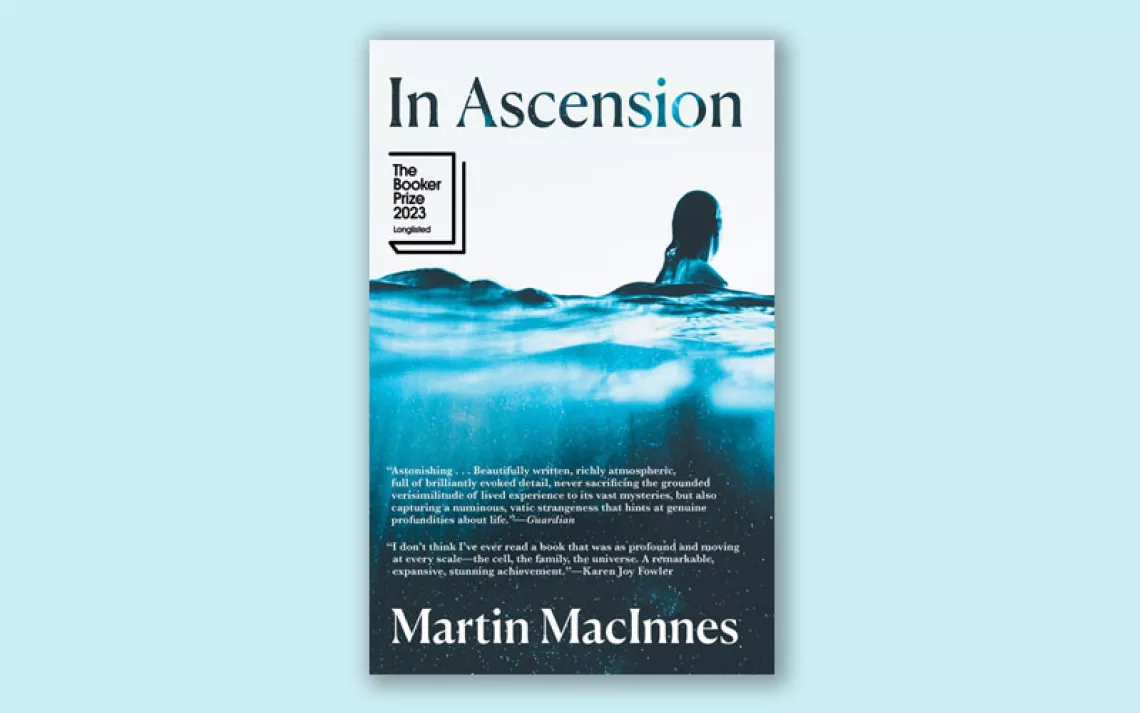4 Must-Read Books for the Summer Season
These stories move us to think more deeply about the human, and more-than-human, world

Photo by iStock/huePhotography
In genres of both fiction and nonfiction, these four books connect us more deeply to all that matters in the human, and more-than-human, world. These stories—on nature in the American South, the history of the bicycle, the aftermath of a natural disaster in Haiti, and questions (with answers) for the future of climate justice—remind us of the lucidity of nature's wisdom, the joy of two wheels and a destination, and the catharsis that comes from knowing your history so that you know where you're coming from.
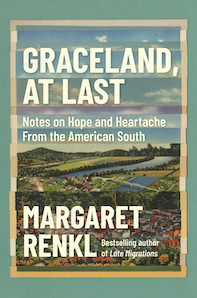
Graceland, At Last: Notes on Hope and Heartache From the American South
By Margaret Renkl
Milkweed Editions, 2022
For a writer, one of the great advantages of publishing a selection of already-published essays is convenience. Most of the hard labor of writing has been done, leaving the writer and her editors with little more to do than select and organize existing works into patterns, like a beachcomber sorting through shells. For a reader, the great virtue of an essay collection is that there’s little commitment involved. Unlike a novel or (most) nonfiction books, you can dip in and out of the text however and wherever you like—like a beachcomber picking through the shells curated by others.
If you’re looking for a beach diversion to complement shell-gathering, you can’t do much better than Margaret Renkl’s new collection of essays, Graceland, At Last. The bite-size pieces here make for perfect beach reading—or, for that matter, lakeside reading, creekside reading, stream-bank reading, pond-edge reading, or wherever you’re spending your summer holiday looking for a dash of literary inspiration.
Renkl is a columnist at The New York Times, and she’s part of the newspaper’s tradition of having a signature voice that can deliver to its mostly urban readership dispatches of the natural world. For a minute, British writer Helen Macdonald had an On Nature column in the Times’ magazine. During the aughts, the paper hosted Verlyn Klinkenborg’s The Rural Life, in which the writer teased musings out of the daily work of caring for animals at his farm in upstate New York. Back in the 1950s and '60s, theater critic Brooke Atkinson’s columns often touched on nature and the environment. (Probably the best-known example of this form are E.B. White’s New Yorker pieces written from his farmhouse in Brooklin, Maine.)
Renkl may fit neatly into the tradition of the provincial writing bucolic epistles for a cosmopolitan audience, but it would be a mistake to put her into the “nature writer” box. Yes, she’s a nature writer. She’s also a Southern writer (a stereotype she pushes back against), and a Christian writer, and, at times, a political writer. Renkl is at once all of those things and none of those things, which only goes to show how she brings the whole of herself to the page. She is, above all, a sensitive writer, with a sensitive person’s knack for noticing details and making connections among those details—the great skill of the best essayists.
Often, that sensitivity is focused on the more-than-human world. About a third of the columns in Graceland, At Last have to do with flora and fauna, or nature and the environment writ large. Sometimes, the subject is grand, like the recovery of the bald eagle, of which she writes, “To see an eagle on the wing is to see something magnificent, to be reminded of the nature of eternity.” More frequently, she’s attracted to the minute and the overlooked: the importance, for pollinators, of keeping grasses unmowed in the springtime and the “pocket[s] of native wilderness” in our cities that provide valuable habitat to critters of all kinds. She’s an instinctual naturalist, never showy about rattling off species of flowers and birds, and (usually) an unsentimental one. Watching a red wasp consume gulf fritillary caterpillars on a passionflower vine, she concludes, “Nature’s wisdom is still wise, even if it’s painful to watch.”
Renkl’s love of place extends to the entirety of her region. An Alabama native who has spent most of her adult life in Nashville, she is enamored with the South, which she repeatedly refers to as her “homeland.” But it’s a troubled love. Renkl is brutally candid about how hard it is to be a Southern progressive, and many of her columns—most of which were written during the Trump presidency—read like messages from someone trapped behind enemy lines. Yet her affection for her home place remains undimmed. In one column, she writes, “Maybe being a Southern writer is only a matter of loving a damaged and damaging place, of loving its flawed and beautiful people, so much that you have to stay there.”
Birdwatchers and treehuggers will come to Graceland, At Last for its poignant sketches of nature. Southerners will come for its enchantment with the South. As a United Church of Christ–raised, Jesuit-educated, present-day spiritual agnostic, I most of all appreciate how Renkl wrestles with questions of faith and the demands of Jesus’s social justice teachings. Renkl describes herself as a “cradle Catholic,” and her faith has a Catholic Worker Movement vibe about it: Feed the poor, love thy neighbor, show mercy even to the criminals, for “mercy will do.” She is turned off by the reactionary politics of many of her fellow believers, who claim the “pro-life” mantle even as they rush to send convicts to the death chamber.
Renkl’s beliefs are strongly held, but her writer’s curiosity saves her from self-righteousness; the homilies never devolve into pieties. Her faith is two parts doubt to one part conviction, and she knows full well that “there will always be disputes about what ‘justice’ means.” That open-mindedness is what makes this collection such a joy to read—no matter whether the subject is captive foxes or immigrant kids put in cages or the challenges of being a good parent, partner, and citizen. Graceland, it turns out, isn’t just a washed-up rock star’s tacky Memphis mansion. Graceland—in the sense of grace that stretches across faith traditions—is a territory of the heart.
—Jason Mark
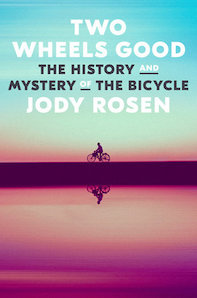
Two Wheels Good: The History and Mystery of the Bicycle
By Jody Rosen
The Crown Publishing Group, 2022
Spare some sympathy for the premodern societies that didn’t have access to one of history’s greatest inventions: the bicycle. Journalist Jody Rosen nods to primeval yearnings to get around on something better than just two feet in his new book, Two Wheels Good: The History and Mystery of the Bicycle, making a case that cycling transformed our relationships with the physical world.
When bicycles were invented in the 19th century, Rosen writes, it was “the realization of a wish as ancient as the dream of flight. It was the elusive personal transport machine, a device that liberated humans from their dependence on draft animals, allowing individuals to move swiftly across land under their own power.” Animals were expensive, excretive, and liable to drop dead. Riding in a carriage or train was dully passive, each passenger just one more piece of cargo. But “a cyclist,” Rosen writes, “was her own locomotive.”
All that and they’re fun too. Rosen’s deeply researched book reels through cycling history, engineering, and politics, but it’s his sheer joy at going out for a spin that’s most irresistible. The writer takes evident pleasure at “the feeling of a particularly free-flowing ride, when your body and being—shoulders, hands, hips, legs, bones, muscles, skin, brain—seem to be inseparable from the strong but supple bicycle frame.”
He's got plenty of company in that sentiment. Cycling fever took hold during the late 19th century, and it’s a treat to dip into the sometimes-hyperbolic language of the time. In one memorable chapter, Rosen excerpts a handful of 1890s divorce proceedings that blame conjugal rifts on the mania for bikes. (An aggrieved husband in Akron, Ohio, charged that his wife, Lena, refusing to cook or keep house, instead “spent nearly all her time riding her wheel in company with people who were strangers to propriety.”)
Some 19th-century women cycled in pants, sparking scandal. Both bloomers and bicycles became fraught symbols of emancipation. Given the virtuous glow that bikes have today, it’s tempting to cast them in the role of historical hero, design marvels empowering free-wheelers and feminists alike. But Rosen mines the archives for a more nuanced, if sometimes fragmented, picture. In his telling, bikes have served as vehicles for both oppression and resistance.
When bicycles arrived in Vietnam, they were a profitable tool of French colonial empire; anti-colonial Vietnamese fighters packed their tubing with explosives to make bombs. Britain’s 19th-century socialist cycling clubs greeted bikes as egalitarian tools. In recent years, however, researchers have found that bike paths and cycling lanes often map neatly onto spreading gentrification.
Rosen writes that the now-familiar image of bikes as planet-loving green machines didn’t gel until relatively late, in a moment with curious parallels to our own. It was a time of rampant inflation and soaring gas prices. Anti-war protests rocked America. An environmental movement targeted the harmful impacts of gas-powered vehicles. For three consecutive years in the early 1970s, bicycles outsold cars in the United States.
Half a century later, a global pandemic sent bike sales soaring once again. City streets became ad hoc bike boulevards. In the summer of 2020, many Black Lives Matter protesters came out pedaling. The environmental devastation wrought by gas-powered vehicles is more apparent than ever. Will we all be riding bikes into a greener future? Cycling is barely 200 years old, its long-term staying power untested.
“The bike probably isn’t eternal. In our age of collapse, what is?” Rosen writes. “But the bicycle is resilient; it has a way of staging comebacks.”
—Jen Rose Smith
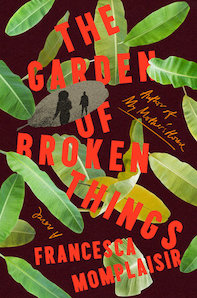
The Garden of Broken Things
By Francesca Momplaisir
Knopf, 2022
As their plane descends toward Haitian soil, Genevieve Ducasse—a psychiatrist, single mother, and third-generation Haitian immigrant living in New York—studies the profile of the 15-year-old young man sitting beside her, cradling his phone: her son Miles. She’s looking for anything—a signal of anticipation, curiosity, presence. Adoration fills her as she keeps searching his face, but also fear, and intent: Not long before Genevieve decided to take Miles on a trip to Haiti to learn more about his heritage, their heritage, he was nearly expelled from school for holding a friend’s flask. Then he was arrested and put into zip ties in the middle of the night, caught with friends in the wrong car. Genevieve’s divorce from Miles’s father, Bright, and its impact on her son weighs heavily. She can feel Miles slipping away, withdrawing into his phone, his friends, his drinking. The trip to Haiti isn’t so much of a vacation for mother and son as it is an intervention.
As the plane lands, and she studies her son’s profile, he turns to face her. Saying nothing. “He doesn’t ask me why I’m staring so hard, but my serious face reinforces the fact that this is not supposed to be a fun trip. It is for us to get to know each other again and teach him not to take things for granted, to be grateful for the kind of life he lives. And, although I can’t say this to him, it is to save his life and mine, because if he dies, I will too.”
The events that follow in Francesca Momplaisir’s visceral The Garden of Broken Things do deliver a kind catharsis for both Genevieve and her son, but not the one she has in mind: born of healing, of time with family, of connection to land and legacy. It’s the catharsis born of broken things, of trauma and crisis when natural disaster strikes, ripping through the lives of the most vulnerable, shattering all they know. Written after the 2010 earthquake that devastated Haiti, Momplaisir re-creates its aftermath in her second novel with such precision and vulgarity that it is impossible to not feel the dust on your face, hear the screams of those all around, and sense the rubble directly beneath your feet. To read The Garden of Broken Things is to experience a natural disaster in its all potency and power. It is also an object lesson in the challenges a single mother can face as she struggles to reconnect with her son in a country she abandoned long ago, even as the color of their skin marks them both in the country they both consider home.
Genevieve lives in New York City with her two children, Miles and Yves, where she continues an on-again off-again relationship with their father, now ex-husband, Bright. We are not given much entrée into their life here: Her fights with Bright and the life they lead here come quickly before we find Genevieve on a plane with Miles to Haiti, her native country—determined to remove him from a life she feels is increasingly pushing him away. Once there, however, lush and lyrical descriptions fill the page of a nation rich with history, independence, and culture—a bustling and vibrant home place that is at once overwhelmingly different and yet all-too-familiar to the place where she visited many times as a child “On either side of the road, produce merchants hand out single samples of ripe keneps for customers to test. The sellers shoo away the repeat tasters, who snack their way through the market for a day’s meal. The bright colors of halves of avocados, papayas, and guavas boast their freshness to attract and reassure skeptical shoppers. A persistent doubter shakes an avocado to see if the seed will bounce around inside, a sign of ripeness.”
None of this matters much to Miles, who only cares about where he can charge his phone so he can get online to connect with whatever he connects to these days—Genevieve doesn’t know, and he doesn’t want her to know. They make their way to the house of her cousin Aetya, a titanic, towering figure with an insuperable smile and a simmering rage. She is an abuser filled with violence. In this complex, multifaceted character, Momplaisir delivers a triumph in the character study of generational trauma and how it is passed down from one parent to the next.
Only a natural disaster of such magnitude as a massive earthquake and its devastating aftermath could shatter Aetya’s formidable shell—and Miles’s for that matter—and catalyze a great reckoning that forces all these richly developed characters to get clear on the fragility of the life they lead, and the truth of what really matters in the end.
—Jonathan Hahn
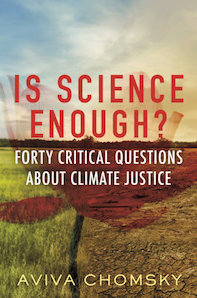
Is Science Enough? Forty Critical Questions About Climate Justice
By Aviva Chomsky
Penguin Random House, 2022
Most of us have become well acquainted with the science of climate change. It’s been discussed in a multitude of books, articles, and video essays. But how familiar are you with cap-and-trade? Carbon tax? What about the concept of a just transition? Speaking for myself: not nearly as much as I should be.
That’s why I was delighted when I stumbled across Is Science Enough? Forty Critical Questions About Climate Justice, the perfect book for those of us who “may be fuzzy on the technical, policy, and social justice aspects” of climate change. In this easy-to-read primer, historian, author, and activist Aviva Chomsky demystifies common, hot-button climate issues and delves into “some of the biggest questions the climate debate frequently evades.” For example, she asks, Why has it been so hard to implement effective policy in the US? How can we clean up our energy grid? What individual actions can make the greatest difference? Although there’s likely no “correct” solution, Chomsky’s responses are extremely persuasive, steeped in social, racial, and economic justice.
These responses also form the foundation of her primary thesis, that relying on science alone won’t be enough to prevent climate catastrophe. Although “science can analyze the physical, material aspects of the problem of CO2emissions,” she writes, it’s not capable of telling us “how to restructure our society and our global and national economies to live within planetary boundaries.”
Most important, it can also perpetuate existing inequalities, as new technologies get coopted into the inequitable systems that created them. The solution? Social movement and political action that creates “the kind of pressure necessary for real structural change.” Thankfully, there are plenty of ways to get involved.
—Krystal Vasquez
 The Magazine of The Sierra Club
The Magazine of The Sierra Club



